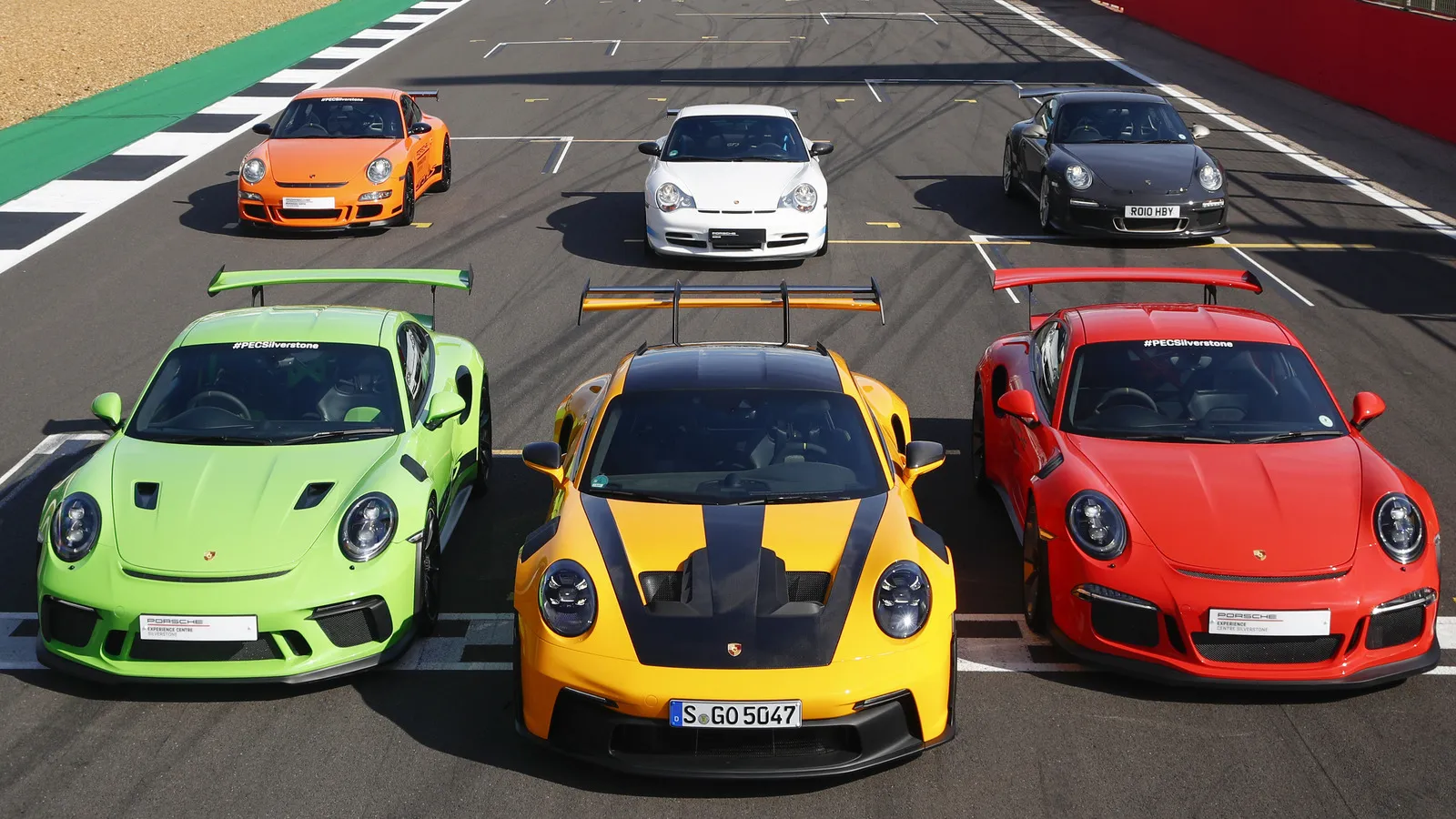Porsche 911 GT3 RS: Every Generation Ranked by Top Speed

The Porsche 911 GT3 RS represents the pinnacle of the brand’s engineering prowess, blending exhilarating speed, advanced aerodynamics, and track-ready performance in a stunning package. As Porsche’s most powerful naturally aspirated model, the GT3 RS has evolved through four distinct generations, each building upon the legacy of its predecessor. From the early days of the water-cooled 996 to the latest 992 iteration, these incredible machines embody the spirit of motorsport, while also catering to enthusiasts who crave the thrill of high-speed driving. In this article, we will rank every generation of the GT3 RS by top speed, shedding light on the innovations and characteristics that define these exceptional vehicles.
| Model Generation | Top Speed | Engine | Horsepower | Transmission | Notes |
|---|---|---|---|---|---|
| 2007-2011 Porsche 911 GT3 RS (Type 997) | 193 mph | 3.6L flat-six / 3.8L flat-six / 4.0L flat-six | 409 hp / 444 hp / 500 hp | 6-speed manual | Highest top speed; wider all-wheel-drive body; 600 limited edition. |
The Evolution of the Porsche 911 GT3 RS
The Porsche 911 GT3 RS has undergone significant changes since its inception. Each generation has brought new innovations and performance enhancements that reflect Porsche’s commitment to racing. Starting with the Type 996, which laid the groundwork, the GT3 RS models have evolved to become more powerful and agile. Each version has unique design features and engineering improvements that cater to track enthusiasts, making the GT3 RS a symbol of speed and precision.
As the GT3 RS line progressed, Porsche introduced advanced technologies to enhance performance. The Type 997 and Type 991 models showcased increased horsepower and superior aerodynamics, making them formidable on the track. The latest Type 992 model continues this tradition, incorporating lightweight materials and refined engineering to improve handling. Every generation not only aims for higher top speeds but also focuses on delivering a thrilling driving experience, highlighting Porsche’s racing heritage.
Understanding Top Speed in Track Racing
Top speed is crucial for track-focused cars like the Porsche 911 GT3 RS, but it isn’t the only factor that defines their performance. While achieving high speeds is impressive, track cars prioritize downforce and cornering agility to navigate tight turns effectively. This means that a car can be incredibly fast on a straight but still excel on a racetrack due to its ability to handle curves with precision.
The design of the GT3 RS models reflects this balance. For instance, the aerodynamic features, such as rear wings and body shapes, are optimized for stability at high speeds. As a result, while the Type 992 GT3 RS has a slightly lower top speed than its predecessors, it showcases remarkable lap times. This emphasizes the importance of overall performance rather than just raw speed, making the GT3 RS a well-rounded choice for racing enthusiasts.
The Unique Features of Each GT3 RS Generation
Each generation of the Porsche 911 GT3 RS boasts unique features that set it apart from its predecessors. For example, the Type 996 introduced the concept of a lightweight, track-ready sports car, focusing on aerodynamics and reduced weight. The Type 997 built upon this foundation, adding more power and an upgraded suspension system that improved handling and responsiveness on both the track and the road.
The later Type 991 and Type 992 models further advanced these elements, incorporating modern technology like dual-clutch transmissions and sophisticated weight-saving techniques. These innovations not only enhanced speed but also improved the overall driving experience. By examining the distinct characteristics of each generation, enthusiasts can appreciate how Porsche has continually pushed the boundaries of performance and design in the GT3 RS lineup.
The Evolution of Performance: A Closer Look at Each GT3 RS Generation
Each generation of the Porsche 911 GT3 RS represents a significant leap in performance technology and engineering prowess. The Type 996, while the least powerful, laid a solid foundation with its lightweight construction and aerodynamic enhancements. This model introduced features like a carbon rear wing, which not only contributed to downforce but also showcased Porsche’s commitment to track performance. As each subsequent model was released, the enhancements became increasingly sophisticated, culminating in the advanced 992 version that utilizes cutting-edge materials and technology.
The Type 997 and Type 991 iterations took these principles further, focusing on maximizing power while improving handling dynamics. The 997 introduced a more powerful engine and all-wheel drive options, while the 991 integrated advanced aerodynamics with a dual-clutch transmission for improved acceleration. Each model’s evolution not only reflects the advances in automotive technology but also Porsche’s dedication to creating a car that is equally at home on the street and the racetrack.
Top Speed vs. Track Performance: Understanding the Balance
While top speed is an appealing metric for many automotive enthusiasts, it is essential to recognize that the true essence of the GT3 RS lies in its track performance. Each generation has been optimized for agility and downforce rather than sheer velocity. For instance, the Type 992 may have a lower top speed than its predecessor, yet it excels on the track, evidenced by its record-breaking lap times. This shift in focus highlights Porsche’s understanding of what drivers truly value in a racing car.
The engineering philosophy behind the GT3 RS emphasizes cornering ability, stability, and driver engagement, often at the expense of outright speed. By prioritizing handling characteristics and response over top speed figures, Porsche has created a vehicle that allows drivers to push the limits of performance in competitive situations. This design philosophy ensures that each GT3 RS not only performs exceptionally well in a straight line but also inspires confidence and precision through every twist and turn on the racetrack.
The Future of the GT3 RS: Innovations and Expectations
As we look ahead, the future of the Porsche 911 GT3 RS is poised to embrace even more innovative technologies and performance enhancements. With advancements in hybrid technology and electric powertrains becoming increasingly prevalent, there is significant speculation about how these changes will influence the next generation of the GT3 RS. Porsche has a rich history of blending performance with sustainability, and the next iteration could redefine what it means to be a track-focused sports car.
Moreover, with each new generation, Porsche has consistently raised the bar in terms of performance metrics and driving experiences. Expectations for the next GT3 RS will likely include lighter materials, improved aerodynamics, and more advanced driver-assistance systems. Enthusiasts can anticipate a vehicle that not only pays homage to its predecessors but also sets new benchmarks in speed, handling, and overall driving pleasure, ensuring that the legacy of the GT3 RS continues to thrive.
The Iconic Design: Aesthetic Evolution of the GT3 RS
The design of the Porsche 911 GT3 RS has evolved remarkably over the years, reflecting both functional and aesthetic changes. Each generation has introduced unique styling cues that enhance aerodynamics while emphasizing the vehicle’s racing heritage. For instance, the transition from the controversial ‘fried egg’ headlights of the Type 996 to the more aggressive and streamlined designs of the later models illustrates Porsche’s commitment to evolving its iconic look while improving performance.
Additionally, features like the prominent rear wing and wide fender flares not only contribute to the car’s aggressive stance but also serve practical purposes in optimizing downforce and stability at high speeds. As we move forward, future designs will likely continue to blend cutting-edge technology with the classic Porsche silhouette, ensuring that the GT3 RS remains instantly recognizable while also pushing the boundaries of modern automotive design.
Frequently Asked Questions
What does GT3 RS mean in Porsche cars?
GT3 RS stands for ‘Gran Turismo 3 Rennsport,’ which means ‘Racing’ in German. It shows that these cars are made for both the road and the racetrack.
How fast can the Porsche 911 GT3 RS go?
The fastest Porsche 911 GT3 RS can reach speeds of up to **193 mph**. This includes models from 2007-2011 and 2015-2019.
What makes the 911 GT3 RS special for racing?
The **911 GT3 RS** is designed to be really fast on tracks. It has special features like a strong engine, lightweight materials, and a great aerodynamic shape.
What is the difference between the GT3 RS and regular Porsche 911?
The GT3 RS is more focused on speed and handling. It has a more powerful engine, better aerodynamics, and features that help it perform well on racetracks.
Why is the top speed of the GT3 RS not the most important thing?
For a racing car like the GT3 RS, **cornering** and control are more important than just speed. It’s built to handle turns and stay stable at high speeds.
What engine does the latest Porsche 911 GT3 RS use?
The newest model, the **2023 911 GT3 RS**, has a **4.0L flat-six engine** that produces **518 horsepower**, making it very powerful for racing.
Can you drive a Porsche 911 GT3 RS on the street?
Yes! The **Porsche 911 GT3 RS** is street-legal, meaning you can drive it on regular roads, but it is also designed to perform excellently on racetracks.
Summary
The content discusses the evolution of the Porsche 911 GT3 RS, highlighting its status as the brand’s most powerful naturally aspirated model and track-focused car. There are four generations: 996, 997, 991, and 992, each with unique features and specifications. The 997 and 991 models share the highest top speed of 193 mph, while the latest 992 model, although slightly slower at 184 mph, boasts superior track performance. The article emphasizes the importance of downforce and agility over sheer top speed in these vehicles, showcasing Porsche’s commitment to engineering excellence in motorsport-inspired designs.






